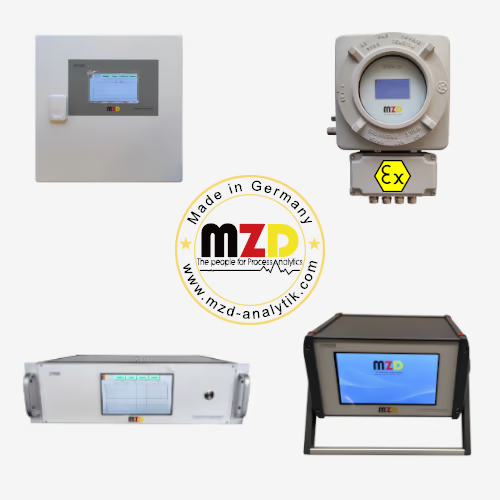
Applications of Thermal Conductivity Analyzer
Air Separation Unit
Air separation plants usually separate air into nitrogen (N2) and oxygen (O2), argon (Ar), and some air separation plants can further separate rare gases, such as neon(Ne), krypton(Kr), and xenon(Xe). In the production process, moisture(H2O), carbon dioxide (CO2) and hydrocarbons(CmHn) need to be removed from the air to ensure safe production, reduce energy consumption and production energy costs, and control the purity of the product gas. Air separation plants can choose to use the following three processes, Cryogenic separation (deep cooling method), Pressure Swing Adsorption(PSA) or Vacuum Pressure Swing Adsorption(VPSA), and membrane separation, depending on factors such as product quality and quantity. Cryogenic separation technologies usually use compression, cooling and expansion followed by selective distillation and gasification of the liquid to produce different products.
SMART-TCD (thermally conductive) can be use to measure percentage O2 concentration for low pressure tower feed, crude argon tower feed, crude argon tower product and oxygen product, and SMART-TCD (thermal conductivity) can also be used to measure argon(Ar) in the crude argon column feed and product, hydrogen(H2) after the deaerating unit, and purity measurements of rare gases such as neon, kryptonm and xenon.
Coal chemical industry
Coal chemical industry generally starts with coal gasification,to convert coal into a syngas mixture of combustible carbon monoxide (CO) and hydrogen (H2), which can then be further used to produce synthetic aromatic organic compounds such as hydrogen (H2), ammonia (NH3), methanol (CH3OH), methane (CH4), propane (C3H8), butane (C4H10), gasoline, and diesel.
SMART-TCD (thermal conductivity) is used to measure 0~2/5/25/100 % oxygen (O2), and 0-5/20/50/100% hydrogen (H2).
Hydrogen-cooled generators
Because hydrogen has low density, high specific heat and highest thermal conductivity, it can be used as a coolant in large generators because of its efficient cooling properties. Helium is also a coolant and is non-flammable, but its high cost hinders its application. Monitoring cooling efficiency for maximum productivity and reducing friction losses as well as a safety factor to avoid explosive gas mixtures requires monitoring the coolant in hydrogen-cooled generators.
In the start-up phase, hydrogen-cooled generators replace the air with a purge of an inert gas such as carbon dioxide (CO2) or argon (Ar), followed by the replacement of the inert gas with hydrogen (H2). In the shutdown phase, these two steps are performed in reverse to the generation of explosive gas mixtures. SMART-TCD (thermally conductive) measurement can be used to measure 0 to 100% carbon dioxide (CO2) or argon (Ar) in air and 0 to 50/80/100% hydrogen (H2) concentration in inert gas, when multiple gas measurement modes can be used to measure different working conditions using the same analyzer.
Metallurgy/Heat Treatment
In metallurgical heat treatment applications, inerting, oxidation, reduction, carburizing, decarburization, nitriding and other processes, the monitoring of gas concentrations of hydrogen (H2), carbon monoxide (CO), carbon dioxide (CO2), methane (CH4), oxygen (O2), water vapor (H2O), nitrogen (N2), and ammonia (NH3) is critical to product quality.
SMART-TCD (thermally conductive) can be used to measure Hydrogen (H2) concentration from 0 to 50/80/100%.
Metallurgy (blast furnace ironmaking)
In steel production, iron is reduced using a Bottom-blown oxygen converter(BOF) or electric arc furnace (EAC) to further reduce impurities such as carbon, nitrogen and hydrogen, which generates large amounts of carbon monoxide (CO), hydrogen (H2) and oxygen (O2).
SMART-TCD (thermal conductivity) is used to measure hydrogen (H2) in the flue gas, at the dust collection bag, and at the coking gas outlet.
Application of SMART series analyzer in Refinery Catalysis
Continuous catalytic reformers (CCR) in refineries need to regenerate catalysts with 100% pure nitrogen, and the presence of hydrogen or hydrocarbons in the nitrogen gas needs to be monitored and regulated. Typically the nitrogen will contain up to 1% hydrogen or up to 15% organic gas mixture, which typically consists of 10.5% propane (C3H8) and 4.5% butane (C4H10). At this point there will be 2 curves, 1 curve for up to 15% organic gas mixture and 1 curve for up to 1% hydrogen (H2). A special linearization of the 2 curves is carried out to set the pure nitrogen midpoint to 50% of the instrument range (12 mA), the full range 100% (20 mA) for nitrogen N2 with 1% hydrogen, and the zero point 0% (4 mA) for 15% organic gas mixture, to achieve SMART-TCD (thermal conductivity) for monitoring and measuring of catalytic processes.
Application of SMART series analyzer in Hydrogen production by water electrolysis
Hydrogen production from water electrolysis is achieved through an electrolysis unit that converts electrical energy into chemical energy to produce hydrogen (H2) and oxygen (O2) from the electrolysis of water. The electrolysis efficiency is controlled by monitoring the hydrogen concentration during the electrolysis process. At this time, hydrogen gas contains a large amount of water vapor, which can affect the measurement results and even damage the sensor.
SMART-TCD (thermally conductivity) can be used to measure hydrogen (H2) purity and O2 in H2, the sensor is protected against condensation and dust.
